Financial Modelling - Questions and Answers
VerifiedAdded on 2022/08/25
|7
|1052
|22
AI Summary
Contribute Materials
Your contribution can guide someone’s learning journey. Share your
documents today.
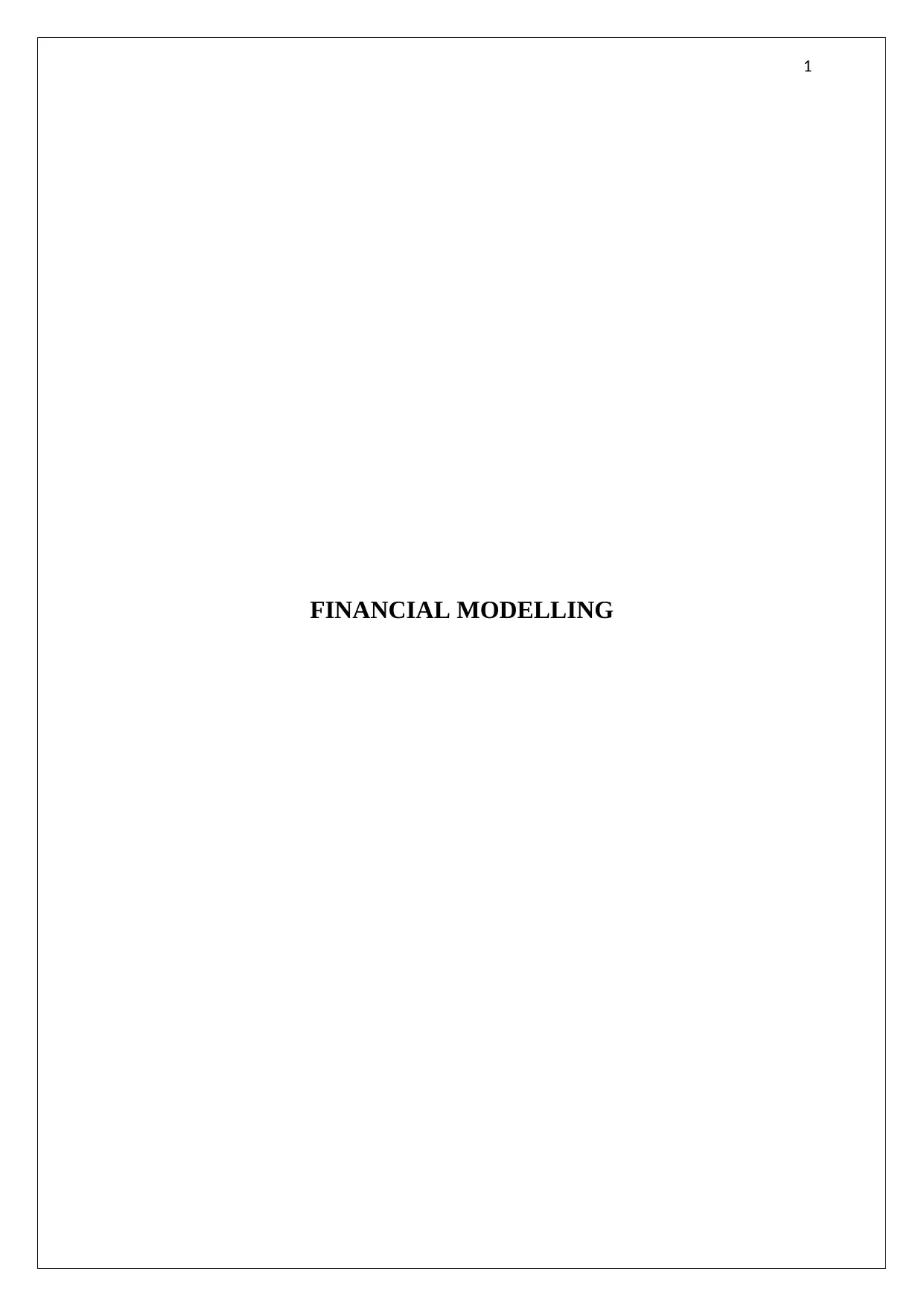
1
FINANCIAL MODELLING
FINANCIAL MODELLING
Secure Best Marks with AI Grader
Need help grading? Try our AI Grader for instant feedback on your assignments.
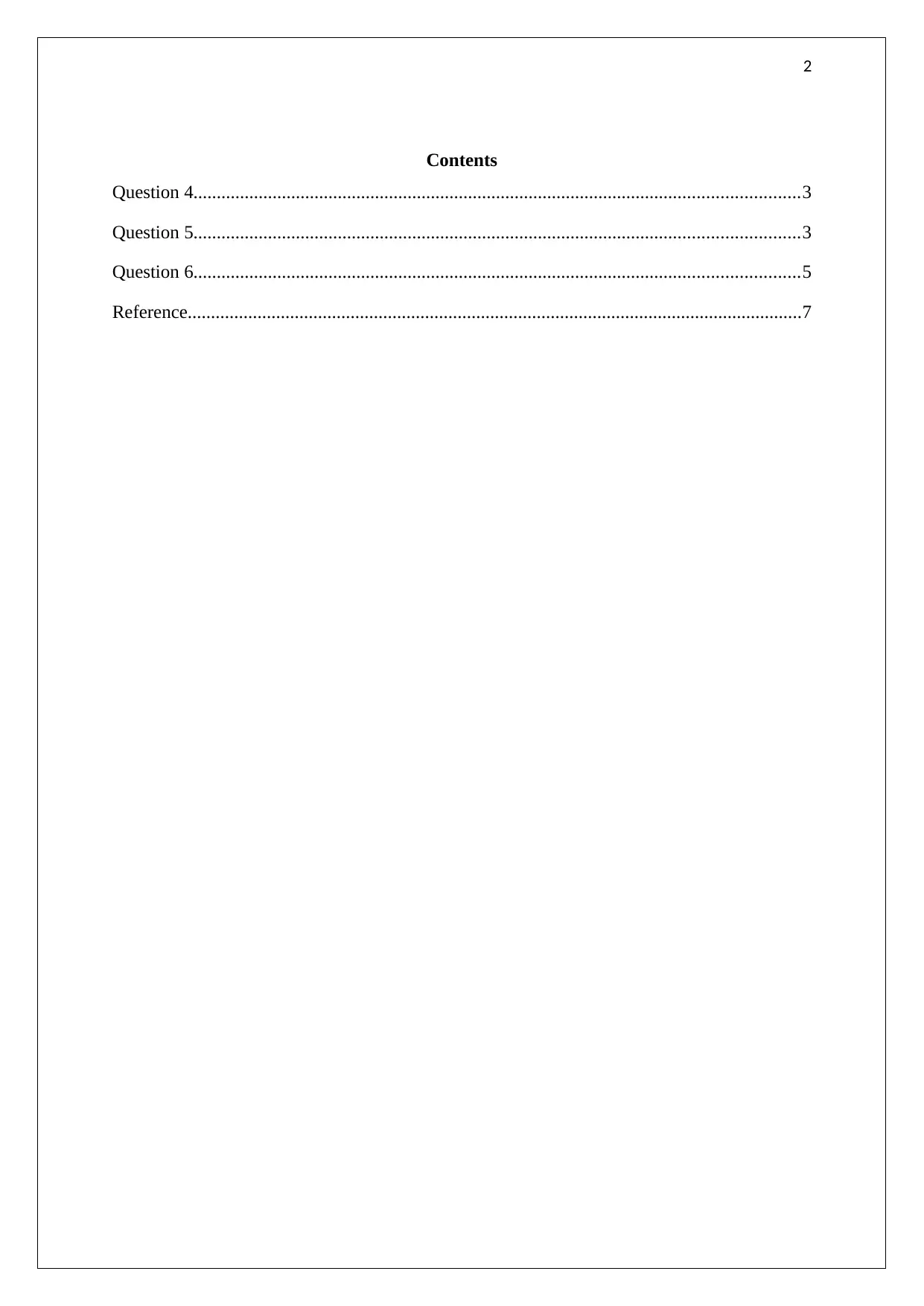
2
Contents
Question 4..................................................................................................................................3
Question 5..................................................................................................................................3
Question 6..................................................................................................................................5
Reference....................................................................................................................................7
Contents
Question 4..................................................................................................................................3
Question 5..................................................................................................................................3
Question 6..................................................................................................................................5
Reference....................................................................................................................................7
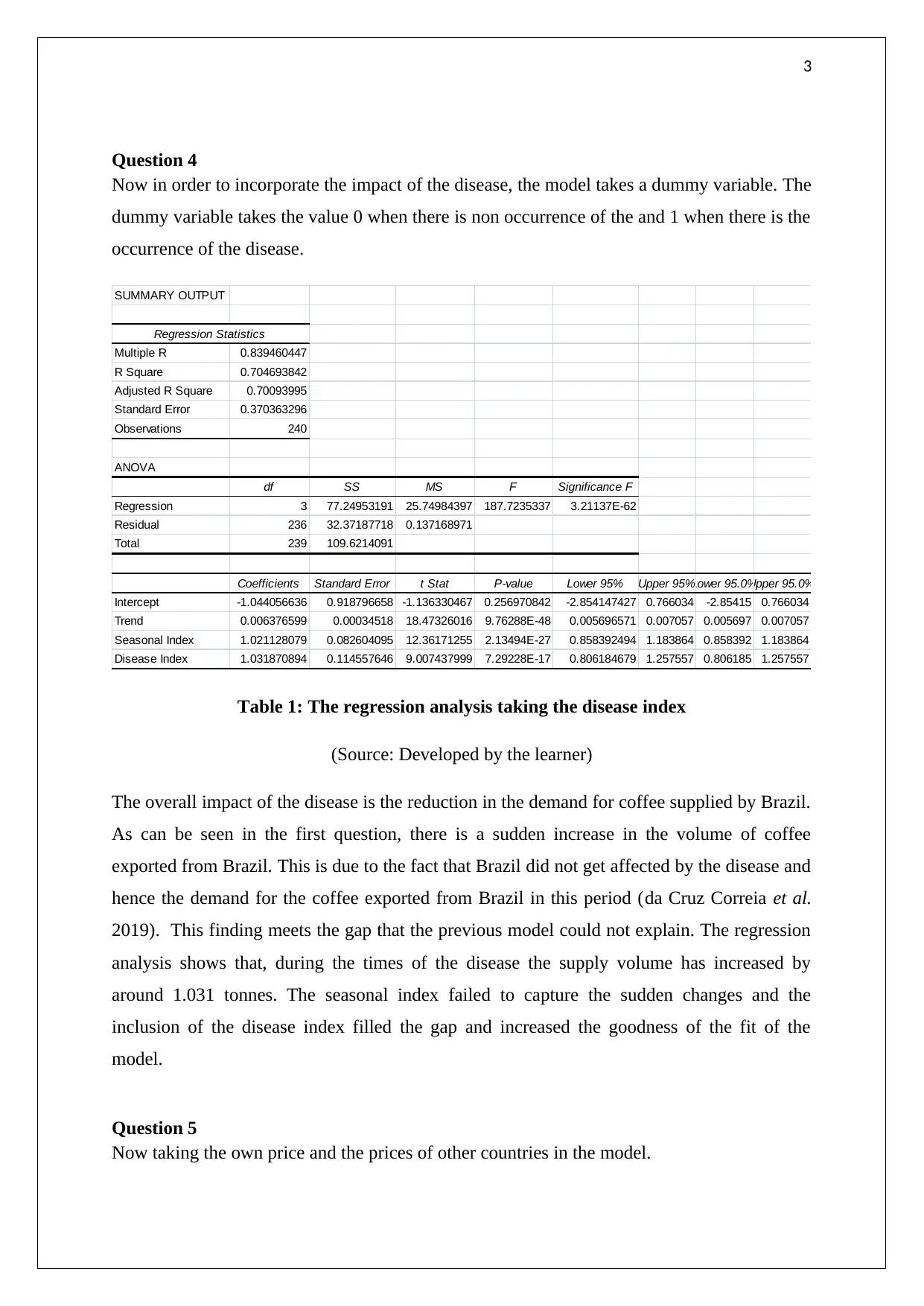
3
Question 4
Now in order to incorporate the impact of the disease, the model takes a dummy variable. The
dummy variable takes the value 0 when there is non occurrence of the and 1 when there is the
occurrence of the disease.
SUMMARY OUTPUT
Regression Statistics
Multiple R 0.839460447
R Square 0.704693842
Adjusted R Square 0.70093995
Standard Error 0.370363296
Observations 240
ANOVA
df SS MS F Significance F
Regression 3 77.24953191 25.74984397 187.7235337 3.21137E-62
Residual 236 32.37187718 0.137168971
Total 239 109.6214091
Coefficients Standard Error t Stat P-value Lower 95% Upper 95%Lower 95.0%Upper 95.0%
Intercept -1.044056636 0.918796658 -1.136330467 0.256970842 -2.854147427 0.766034 -2.85415 0.766034
Trend 0.006376599 0.00034518 18.47326016 9.76288E-48 0.005696571 0.007057 0.005697 0.007057
Seasonal Index 1.021128079 0.082604095 12.36171255 2.13494E-27 0.858392494 1.183864 0.858392 1.183864
Disease Index 1.031870894 0.114557646 9.007437999 7.29228E-17 0.806184679 1.257557 0.806185 1.257557
Table 1: The regression analysis taking the disease index
(Source: Developed by the learner)
The overall impact of the disease is the reduction in the demand for coffee supplied by Brazil.
As can be seen in the first question, there is a sudden increase in the volume of coffee
exported from Brazil. This is due to the fact that Brazil did not get affected by the disease and
hence the demand for the coffee exported from Brazil in this period (da Cruz Correia et al.
2019). This finding meets the gap that the previous model could not explain. The regression
analysis shows that, during the times of the disease the supply volume has increased by
around 1.031 tonnes. The seasonal index failed to capture the sudden changes and the
inclusion of the disease index filled the gap and increased the goodness of the fit of the
model.
Question 5
Now taking the own price and the prices of other countries in the model.
Question 4
Now in order to incorporate the impact of the disease, the model takes a dummy variable. The
dummy variable takes the value 0 when there is non occurrence of the and 1 when there is the
occurrence of the disease.
SUMMARY OUTPUT
Regression Statistics
Multiple R 0.839460447
R Square 0.704693842
Adjusted R Square 0.70093995
Standard Error 0.370363296
Observations 240
ANOVA
df SS MS F Significance F
Regression 3 77.24953191 25.74984397 187.7235337 3.21137E-62
Residual 236 32.37187718 0.137168971
Total 239 109.6214091
Coefficients Standard Error t Stat P-value Lower 95% Upper 95%Lower 95.0%Upper 95.0%
Intercept -1.044056636 0.918796658 -1.136330467 0.256970842 -2.854147427 0.766034 -2.85415 0.766034
Trend 0.006376599 0.00034518 18.47326016 9.76288E-48 0.005696571 0.007057 0.005697 0.007057
Seasonal Index 1.021128079 0.082604095 12.36171255 2.13494E-27 0.858392494 1.183864 0.858392 1.183864
Disease Index 1.031870894 0.114557646 9.007437999 7.29228E-17 0.806184679 1.257557 0.806185 1.257557
Table 1: The regression analysis taking the disease index
(Source: Developed by the learner)
The overall impact of the disease is the reduction in the demand for coffee supplied by Brazil.
As can be seen in the first question, there is a sudden increase in the volume of coffee
exported from Brazil. This is due to the fact that Brazil did not get affected by the disease and
hence the demand for the coffee exported from Brazil in this period (da Cruz Correia et al.
2019). This finding meets the gap that the previous model could not explain. The regression
analysis shows that, during the times of the disease the supply volume has increased by
around 1.031 tonnes. The seasonal index failed to capture the sudden changes and the
inclusion of the disease index filled the gap and increased the goodness of the fit of the
model.
Question 5
Now taking the own price and the prices of other countries in the model.
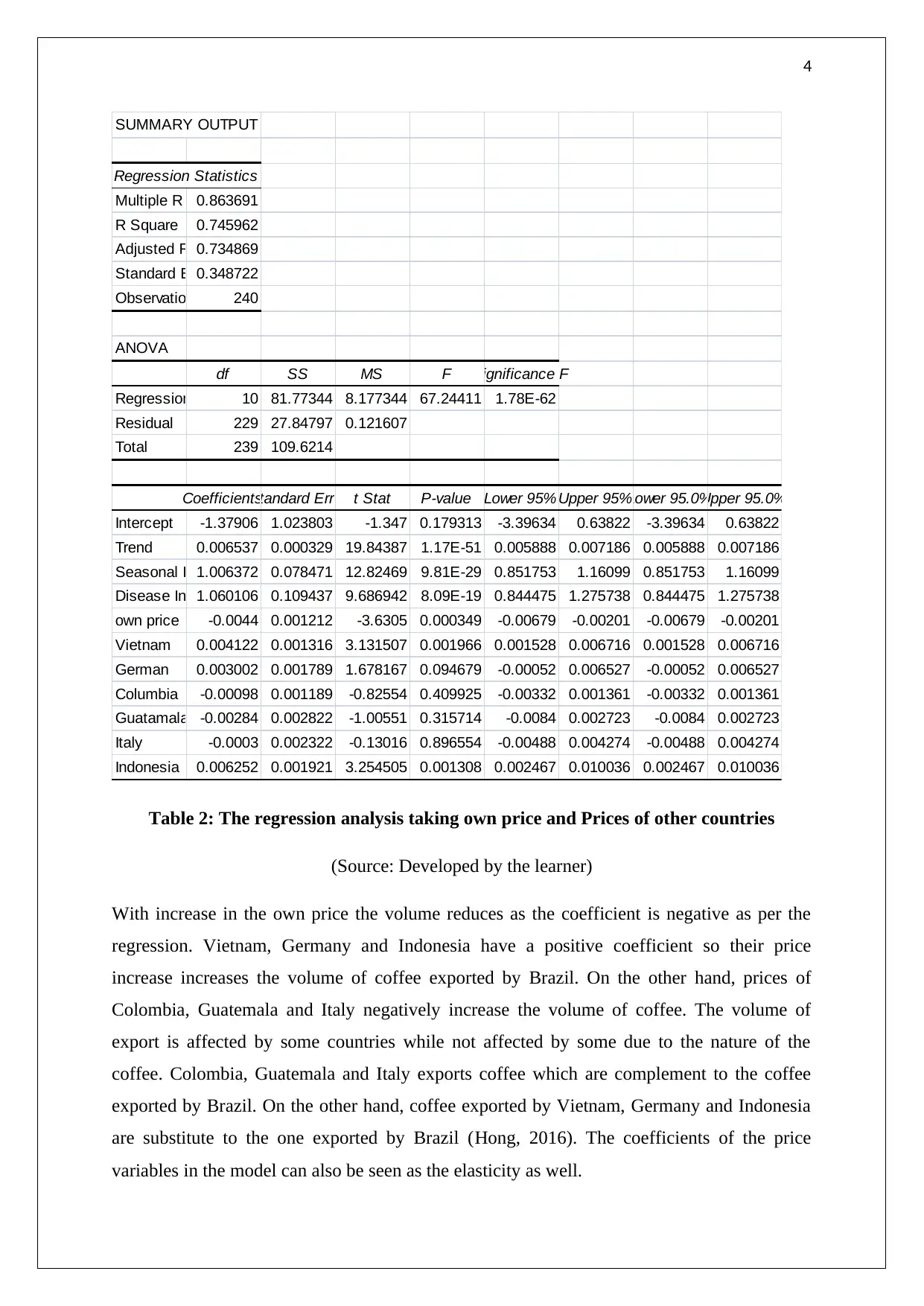
4
SUMMARY OUTPUT
Regression Statistics
Multiple R 0.863691
R Square 0.745962
Adjusted R Square0.734869
Standard Error0.348722
Observations 240
ANOVA
df SS MS F Significance F
Regression 10 81.77344 8.177344 67.24411 1.78E-62
Residual 229 27.84797 0.121607
Total 239 109.6214
CoefficientsStandard Error t Stat P-value Lower 95% Upper 95%Lower 95.0%Upper 95.0%
Intercept -1.37906 1.023803 -1.347 0.179313 -3.39634 0.63822 -3.39634 0.63822
Trend 0.006537 0.000329 19.84387 1.17E-51 0.005888 0.007186 0.005888 0.007186
Seasonal Index1.006372 0.078471 12.82469 9.81E-29 0.851753 1.16099 0.851753 1.16099
Disease Index1.060106 0.109437 9.686942 8.09E-19 0.844475 1.275738 0.844475 1.275738
own price -0.0044 0.001212 -3.6305 0.000349 -0.00679 -0.00201 -0.00679 -0.00201
Vietnam 0.004122 0.001316 3.131507 0.001966 0.001528 0.006716 0.001528 0.006716
German 0.003002 0.001789 1.678167 0.094679 -0.00052 0.006527 -0.00052 0.006527
Columbia -0.00098 0.001189 -0.82554 0.409925 -0.00332 0.001361 -0.00332 0.001361
Guatamala -0.00284 0.002822 -1.00551 0.315714 -0.0084 0.002723 -0.0084 0.002723
Italy -0.0003 0.002322 -0.13016 0.896554 -0.00488 0.004274 -0.00488 0.004274
Indonesia 0.006252 0.001921 3.254505 0.001308 0.002467 0.010036 0.002467 0.010036
Table 2: The regression analysis taking own price and Prices of other countries
(Source: Developed by the learner)
With increase in the own price the volume reduces as the coefficient is negative as per the
regression. Vietnam, Germany and Indonesia have a positive coefficient so their price
increase increases the volume of coffee exported by Brazil. On the other hand, prices of
Colombia, Guatemala and Italy negatively increase the volume of coffee. The volume of
export is affected by some countries while not affected by some due to the nature of the
coffee. Colombia, Guatemala and Italy exports coffee which are complement to the coffee
exported by Brazil. On the other hand, coffee exported by Vietnam, Germany and Indonesia
are substitute to the one exported by Brazil (Hong, 2016). The coefficients of the price
variables in the model can also be seen as the elasticity as well.
SUMMARY OUTPUT
Regression Statistics
Multiple R 0.863691
R Square 0.745962
Adjusted R Square0.734869
Standard Error0.348722
Observations 240
ANOVA
df SS MS F Significance F
Regression 10 81.77344 8.177344 67.24411 1.78E-62
Residual 229 27.84797 0.121607
Total 239 109.6214
CoefficientsStandard Error t Stat P-value Lower 95% Upper 95%Lower 95.0%Upper 95.0%
Intercept -1.37906 1.023803 -1.347 0.179313 -3.39634 0.63822 -3.39634 0.63822
Trend 0.006537 0.000329 19.84387 1.17E-51 0.005888 0.007186 0.005888 0.007186
Seasonal Index1.006372 0.078471 12.82469 9.81E-29 0.851753 1.16099 0.851753 1.16099
Disease Index1.060106 0.109437 9.686942 8.09E-19 0.844475 1.275738 0.844475 1.275738
own price -0.0044 0.001212 -3.6305 0.000349 -0.00679 -0.00201 -0.00679 -0.00201
Vietnam 0.004122 0.001316 3.131507 0.001966 0.001528 0.006716 0.001528 0.006716
German 0.003002 0.001789 1.678167 0.094679 -0.00052 0.006527 -0.00052 0.006527
Columbia -0.00098 0.001189 -0.82554 0.409925 -0.00332 0.001361 -0.00332 0.001361
Guatamala -0.00284 0.002822 -1.00551 0.315714 -0.0084 0.002723 -0.0084 0.002723
Italy -0.0003 0.002322 -0.13016 0.896554 -0.00488 0.004274 -0.00488 0.004274
Indonesia 0.006252 0.001921 3.254505 0.001308 0.002467 0.010036 0.002467 0.010036
Table 2: The regression analysis taking own price and Prices of other countries
(Source: Developed by the learner)
With increase in the own price the volume reduces as the coefficient is negative as per the
regression. Vietnam, Germany and Indonesia have a positive coefficient so their price
increase increases the volume of coffee exported by Brazil. On the other hand, prices of
Colombia, Guatemala and Italy negatively increase the volume of coffee. The volume of
export is affected by some countries while not affected by some due to the nature of the
coffee. Colombia, Guatemala and Italy exports coffee which are complement to the coffee
exported by Brazil. On the other hand, coffee exported by Vietnam, Germany and Indonesia
are substitute to the one exported by Brazil (Hong, 2016). The coefficients of the price
variables in the model can also be seen as the elasticity as well.
Secure Best Marks with AI Grader
Need help grading? Try our AI Grader for instant feedback on your assignments.
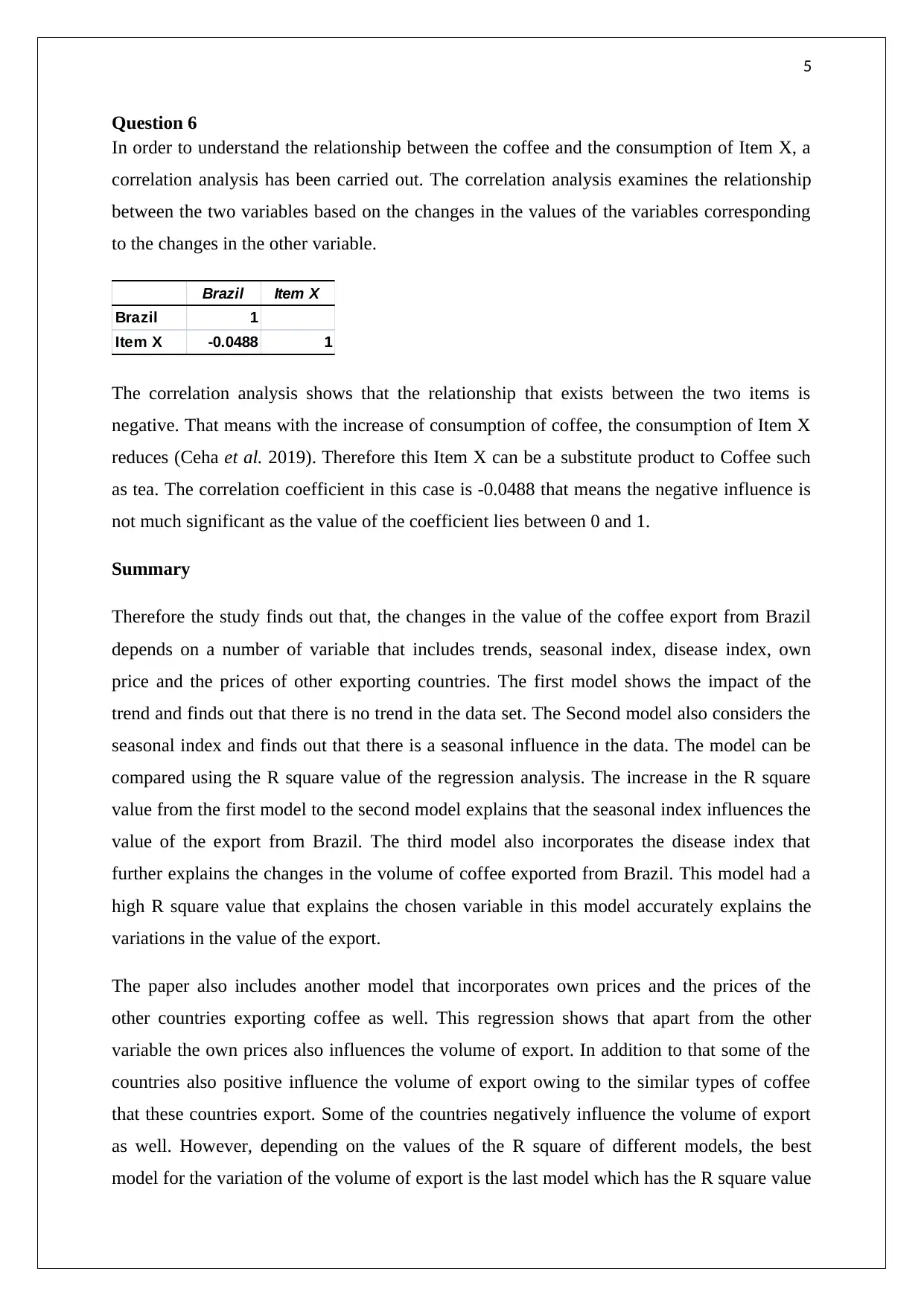
5
Question 6
In order to understand the relationship between the coffee and the consumption of Item X, a
correlation analysis has been carried out. The correlation analysis examines the relationship
between the two variables based on the changes in the values of the variables corresponding
to the changes in the other variable.
Brazil Item X
Brazil 1
Item X -0.0488 1
The correlation analysis shows that the relationship that exists between the two items is
negative. That means with the increase of consumption of coffee, the consumption of Item X
reduces (Ceha et al. 2019). Therefore this Item X can be a substitute product to Coffee such
as tea. The correlation coefficient in this case is -0.0488 that means the negative influence is
not much significant as the value of the coefficient lies between 0 and 1.
Summary
Therefore the study finds out that, the changes in the value of the coffee export from Brazil
depends on a number of variable that includes trends, seasonal index, disease index, own
price and the prices of other exporting countries. The first model shows the impact of the
trend and finds out that there is no trend in the data set. The Second model also considers the
seasonal index and finds out that there is a seasonal influence in the data. The model can be
compared using the R square value of the regression analysis. The increase in the R square
value from the first model to the second model explains that the seasonal index influences the
value of the export from Brazil. The third model also incorporates the disease index that
further explains the changes in the volume of coffee exported from Brazil. This model had a
high R square value that explains the chosen variable in this model accurately explains the
variations in the value of the export.
The paper also includes another model that incorporates own prices and the prices of the
other countries exporting coffee as well. This regression shows that apart from the other
variable the own prices also influences the volume of export. In addition to that some of the
countries also positive influence the volume of export owing to the similar types of coffee
that these countries export. Some of the countries negatively influence the volume of export
as well. However, depending on the values of the R square of different models, the best
model for the variation of the volume of export is the last model which has the R square value
Question 6
In order to understand the relationship between the coffee and the consumption of Item X, a
correlation analysis has been carried out. The correlation analysis examines the relationship
between the two variables based on the changes in the values of the variables corresponding
to the changes in the other variable.
Brazil Item X
Brazil 1
Item X -0.0488 1
The correlation analysis shows that the relationship that exists between the two items is
negative. That means with the increase of consumption of coffee, the consumption of Item X
reduces (Ceha et al. 2019). Therefore this Item X can be a substitute product to Coffee such
as tea. The correlation coefficient in this case is -0.0488 that means the negative influence is
not much significant as the value of the coefficient lies between 0 and 1.
Summary
Therefore the study finds out that, the changes in the value of the coffee export from Brazil
depends on a number of variable that includes trends, seasonal index, disease index, own
price and the prices of other exporting countries. The first model shows the impact of the
trend and finds out that there is no trend in the data set. The Second model also considers the
seasonal index and finds out that there is a seasonal influence in the data. The model can be
compared using the R square value of the regression analysis. The increase in the R square
value from the first model to the second model explains that the seasonal index influences the
value of the export from Brazil. The third model also incorporates the disease index that
further explains the changes in the volume of coffee exported from Brazil. This model had a
high R square value that explains the chosen variable in this model accurately explains the
variations in the value of the export.
The paper also includes another model that incorporates own prices and the prices of the
other countries exporting coffee as well. This regression shows that apart from the other
variable the own prices also influences the volume of export. In addition to that some of the
countries also positive influence the volume of export owing to the similar types of coffee
that these countries export. Some of the countries negatively influence the volume of export
as well. However, depending on the values of the R square of different models, the best
model for the variation of the volume of export is the last model which has the R square value
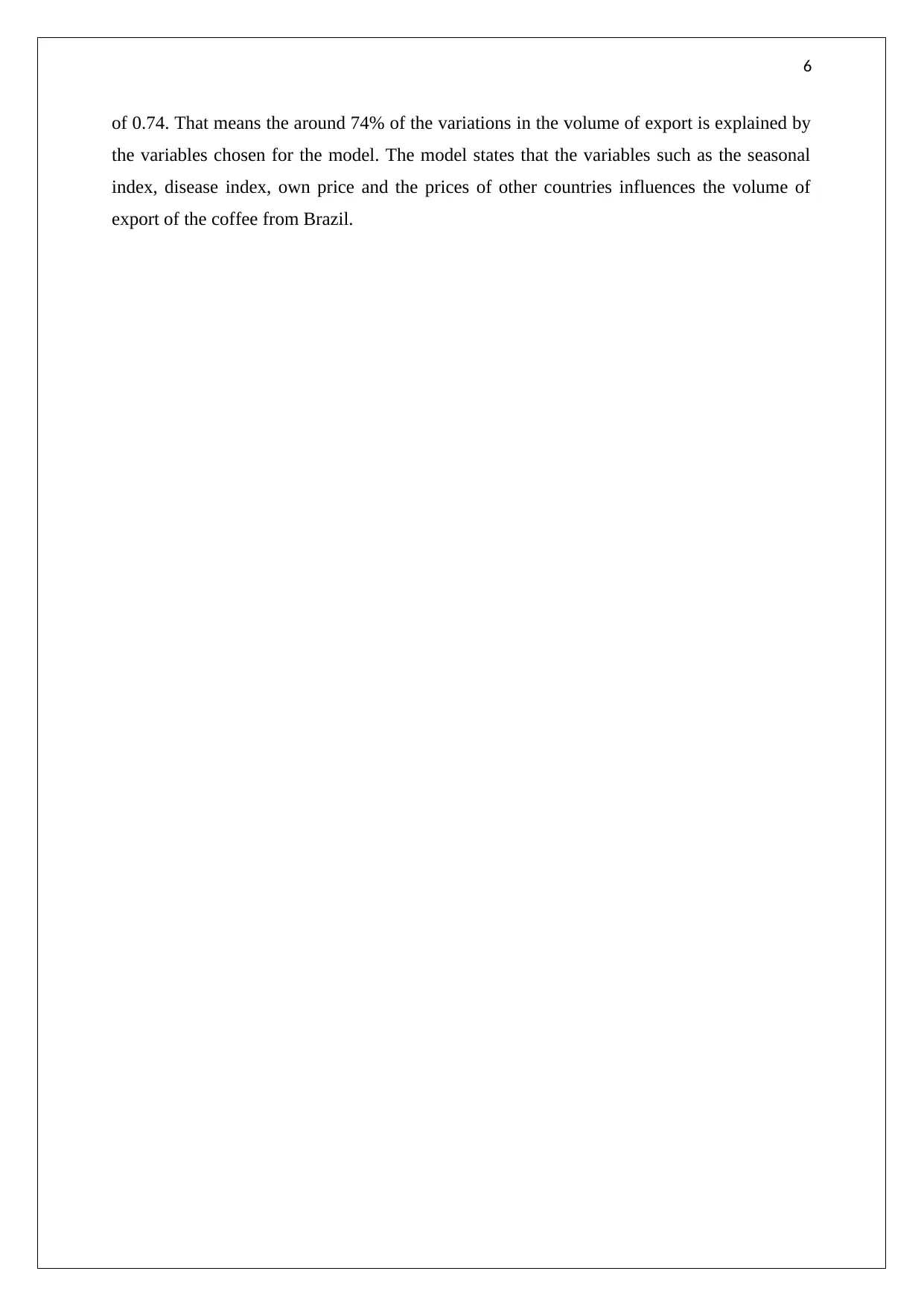
6
of 0.74. That means the around 74% of the variations in the volume of export is explained by
the variables chosen for the model. The model states that the variables such as the seasonal
index, disease index, own price and the prices of other countries influences the volume of
export of the coffee from Brazil.
of 0.74. That means the around 74% of the variations in the volume of export is explained by
the variables chosen for the model. The model states that the variables such as the seasonal
index, disease index, own price and the prices of other countries influences the volume of
export of the coffee from Brazil.
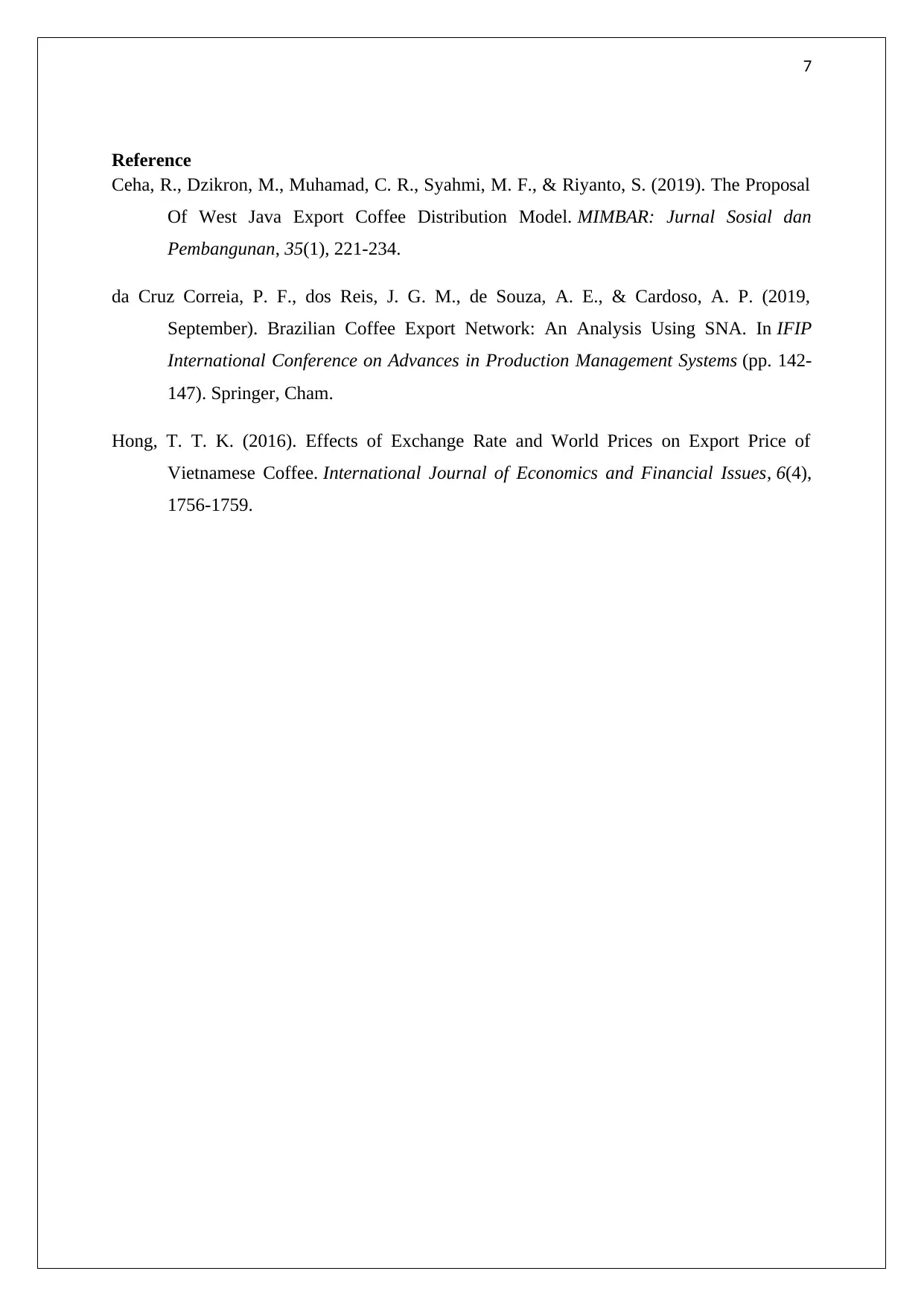
7
Reference
Ceha, R., Dzikron, M., Muhamad, C. R., Syahmi, M. F., & Riyanto, S. (2019). The Proposal
Of West Java Export Coffee Distribution Model. MIMBAR: Jurnal Sosial dan
Pembangunan, 35(1), 221-234.
da Cruz Correia, P. F., dos Reis, J. G. M., de Souza, A. E., & Cardoso, A. P. (2019,
September). Brazilian Coffee Export Network: An Analysis Using SNA. In IFIP
International Conference on Advances in Production Management Systems (pp. 142-
147). Springer, Cham.
Hong, T. T. K. (2016). Effects of Exchange Rate and World Prices on Export Price of
Vietnamese Coffee. International Journal of Economics and Financial Issues, 6(4),
1756-1759.
Reference
Ceha, R., Dzikron, M., Muhamad, C. R., Syahmi, M. F., & Riyanto, S. (2019). The Proposal
Of West Java Export Coffee Distribution Model. MIMBAR: Jurnal Sosial dan
Pembangunan, 35(1), 221-234.
da Cruz Correia, P. F., dos Reis, J. G. M., de Souza, A. E., & Cardoso, A. P. (2019,
September). Brazilian Coffee Export Network: An Analysis Using SNA. In IFIP
International Conference on Advances in Production Management Systems (pp. 142-
147). Springer, Cham.
Hong, T. T. K. (2016). Effects of Exchange Rate and World Prices on Export Price of
Vietnamese Coffee. International Journal of Economics and Financial Issues, 6(4),
1756-1759.
1 out of 7
Your All-in-One AI-Powered Toolkit for Academic Success.
+13062052269
info@desklib.com
Available 24*7 on WhatsApp / Email
![[object Object]](/_next/static/media/star-bottom.7253800d.svg)
Unlock your academic potential
© 2024 | Zucol Services PVT LTD | All rights reserved.